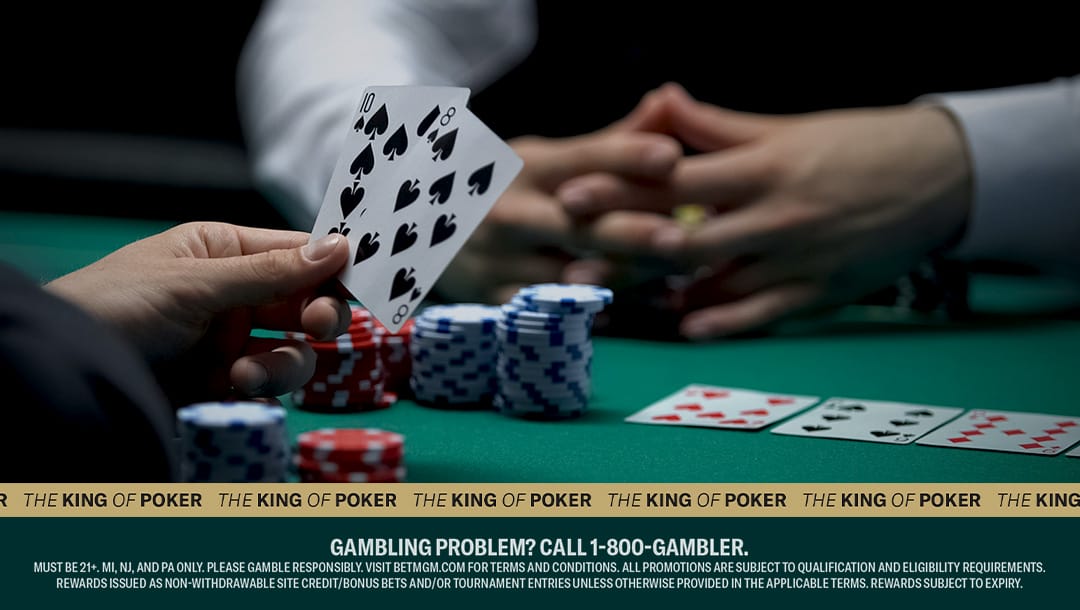
The shove is the all-in move in poker. It is the favorite action of most players, as it is the ultimate move – the most a player can bet and put it all on the line. All or nothing. A rush. Risk for the possibility of a reward. Double a stack or take a walk. It can be the most confident phrase a player utters or the most terrifying one: “I’m all in.”
A player can minimize the risk factor in an all-in situation by using solid strategy and analysis to determine that they are shoving with the best hand. Or a player can maximize the adrenaline and risk all of their chips on a bluff – a bluff shove, to be exact.
The bluff shove is sometimes regarded as one of the best poker bluffing strategies for pros, but pro status is not required to pull it off.
What Is a Bluff Shove in Poker?
A bluff shove is a poker move that is an all-in move with a bluff or semi-bluff.
The full bluff shove is one in which the player moving all-in does not have the nuts or even a particularly good hand. It often happens in position – button, small blind, or big blind – in preflop situations if the player has good reads on the others at the table and thinks it has a good chance of prompting an opponent to fold.
The semi-bluff shove is much more common and happens as the culmination of a semi-bluff. There is some equity in the hand post flop, such as a straight or flush draw, and the opponent is clearly not holding the nuts. It can happen after the flop, turn, or river, when the player sees an opponent following their semi-bluff or chasing a draw themselves. This bluff shove is not a complete bluff, but it is still a bit risky.
When and How to Effectively Bluff Shove
A complete bluff shove is ideal when in position and facing weak players. The best situations for this move are:
- In position against a weaker player or loose player who likes to see cheap flops.
- In a post-flop pot with several players who try to check around to see the turn.
- On a rainbow board facing only one or two passive opponents.
The more common move is the semi bluff shove, in which the bluffer has some draws on the board. It can also be a follow-up move to a semi-bluff when the opponent appears to be chasing or holding a weak pair after the turn or river. While there are several factors to consider, such as player reads and stack sizes, the semi-bluff shove can work if:
- An opponent with fewer chips is chasing a straight or flush draw.
- Only one or two opponents see a flop and don’t appear strong.
- An opponent bets preflop based on position alone, such as the button, and an overbet from the small or big blind could prompt a fold.
- Odds show an approximate flip with a draw versus an overpair.
- Final move of a well-played triple barrel bluff.
Common Mistakes to Avoid With Bluff Shoving
New players can find it hard to tell if someone is bluffing in poker, much less when to bluff in poker on their own. However, the above guidelines can direct any player to make the proper considerations and go for it when the time is right.
Sometimes, adrenaline gets the best of players, though, and they make mistakes when trying to bluff shove. Some of the most common mistakes, according to a number of poker coaches, are:
- Letting personal feelings dictate the bluff shove, such as having lost some pots to the villain in past hands and wanting revenge.
- Not being able to detect one’s own tilt, which can lead to an emotional shove instead of a math-based bluff.
- Trying to bluff shove without allowing sufficient time at the table to read opponents and determine their playing styles.
- Not using tools like online odds and equity calculators when considering bluffs in online poker.
As Mike Sexton once said and many others have echoed, poker takes “a minute to learn but a lifetime to master.” Learning how and when to bluff, much less bluff shove poker hands, is something to be practiced over time.
Play Poker Online at BetMGM Poker
There is no better place to practice bluffing, including the semi-bluff and bluff shove, than at online poker tables. The opportunity to play micro stakes cash games and tournaments is an ideal time to try some moves and strategies.
Play poker now at BetMGM Poker online via legal, licensed, and regulated poker operations.


